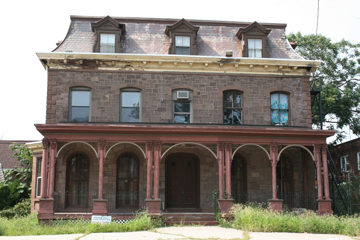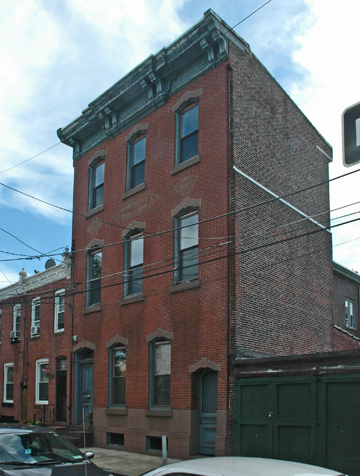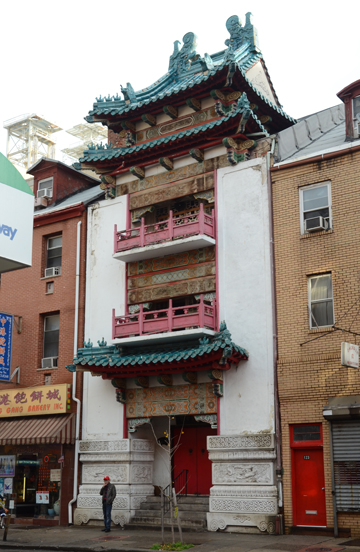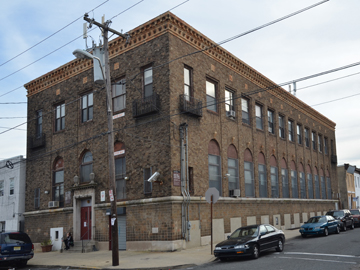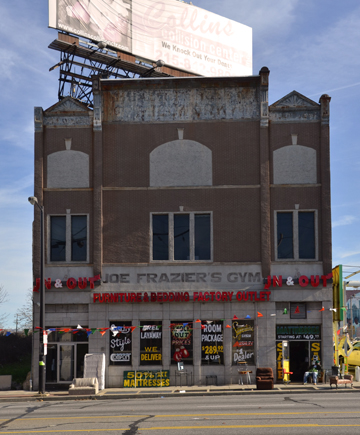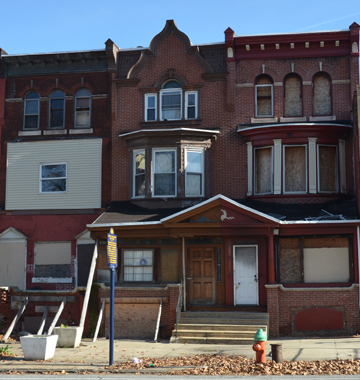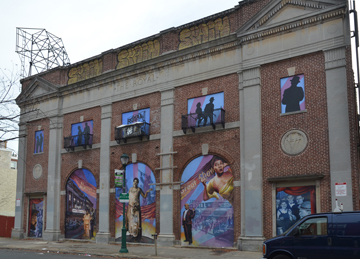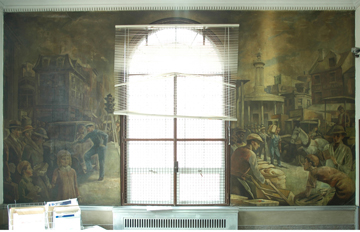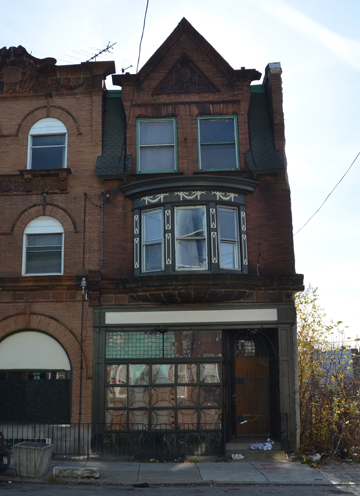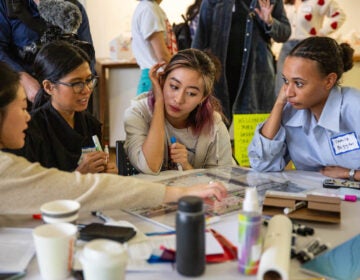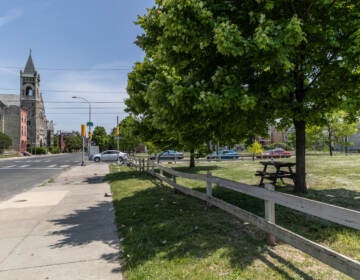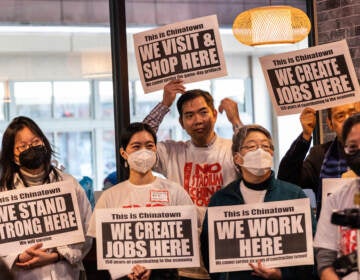2011 Endangered List spotlights anchors of the community
In recent years, the Preservation Alliance for Greater Philadelphia has made an effort to engage African-American organizations and neighborhoods in protecting resources and creating programs that highlight their history. That effort has been broadened in the selection of the “2011 Endangered Properties List,” which this year identifies nine sites that represent the cultural heritage of a variety of communities, past and present, throughout the city.
“Many of the newer groups that had come to Philadelphia – and some of the older groups – did not necessarily create the buildings in which there might be important community or cultural activities related to that neighborhood,” explained John Gallery, executive director of the Preservation Alliance. “So, the uses of the building were more connected to a particular population than the creation of the building itself.”
The list includes community centers, a soup kitchen, a movie house, a mural, the homes of a legendary musician and a lesser-known artist, and the former gym of a boxing giant. The thread that runs through this selection, Gallery said, is that “a lot of them were not about high-style architecture. They were about events and activities that were tied specifically to the different groups.”
Two of the properties on the 2011 list were nominated by neighbors concerned about their protection.
The Historical Society of Frankford had been watching over the state of the New Frankford Y for a long time, “both for its architectural importance in that it’s a very rare brownstone in that part of the city, and as a handsome building that had been a mill owner’s home” when it was built in 1866, said Ben Leech, director of advocacy for the Preservation Alliance.
Known as the Garsed-Bromley Mansion, the site was transformed in 1941 by the YWCA into a neighborhood center where USO hostesses were trained during the Second World War. The Y provided educational classes and social services into the 1960s, “when integration in the Northeast became a hot-button issue. One of the things the Y was well remembered for was a periodical published in the basement called The Northeast Liberator, a mimeographed neighborhood newsletter advocating for racial integration,” Leech said.
The center closed in 2009 due to budget shortfalls. Some neighbors now fear that the vacant building will become a lure to vandals and a danger to children, and there have been calls for its demolition. In response, the Historical Society is working with the Preservation Alliance in drafting the building’s nomination to the Philadelphia Register of Historic Places. “Everyone hopes a new community use can be found,” Leech said, but they would be satisfied with residential or other use for the site, which is scheduled for sheriff’s sale. “The concern right now is for the building.”
When the Preservation Alliance was conducting outreach in Fishtown last year, residents identified the Kensington Soup Society, erected in 1870, as a building close to the community’s heart. “In the 19th century, soup societies were sort of social institutions for federal assistance. Every neighborhood had a soup society funded by the captains of industry of each neighborhood. They served the working poor and indigent in every section of the city,” Leech explained.
Until its closure in 2008, the Kensington site was the oldest soup society in the city. “There are only three surviving buildings, and this is the only one of them that is not on the Philadelphia Register,” Leech said. “It’s a distinctive, handsome building,” but its real value is that it was “the anchor or a large part of the working-class neighborhood for centuries.”
The property was purchased by a developer who had planned to convert it into residences, but that hasn’t happened. The New Kensington Community Development Corporation has completed a nomination for the building that is pending before the Philadelphia Historical Commission.
The Preservation Alliance contacted the Chinatown CDC for help in highlighting a cherished site in that community. They identified the Chinese Cultural and Community Center, which served as the icon of Philadelphia’s Chinatown before the arrival of the Friendship Gate in 1984. The community center had been a YMCA chapter, established in 1955, and housed a collection of cultural artifacts. It provided classes in language, cooking and the arts, and hosted traditional New Year banquets. The beautiful façade was assembled from pieces of the Chinese Pavilion at the 1967 Montreal Expo, but the building itself was a much older row house. The center closed in 2007, and the CDC is building a new community center on the other side of the Vine Street Expressway.
“Nobody recognizes an immediate not-for-profit purpose for the building,” Leech said, “but I think commercial redevelopment would be appropriate and attainable.”
The plight of the Stiffel Senior Center in South Philadelphia received attention last spring, when a longtime art teacher tried to raise funds to keep the building operating. Designed by Frank Hahn in 1928 as the Jewish Education Center No. 2, it provided Hebrew classes, recreation and social functions, and hosted a performance by student cantor Eddie Fisher before his rise to stardom.
“What I thought was fascinating about the history of the building is that it virtually burnt down in 1985” in an arson attack, Leech said. But it was rebuilt and “reinvented as not just a Jewish community center, but a community center that serves a number of other immigrant groups that were coming into the neighborhood. It was recognized and cherished as this melting pot of Philadelphia. There was still some of the old guard Jewish seniors alongside the Vietnamese and Mexican. They were all seniors, all coming together at this site. They saw it as something special.”
The Jewish Federation of Greater Philadelphia closed the center last May, citing rising maintenance costs. The Preservation Alliance is recommending that the building be listed on the Philadelphia Register, and possible reuse as a charter school or senior housing.
John Gallery said many of the buildings on the endangered list may not continue in their former roles. “So in addition to nominating those that seem important, there is also the possibility of looking at some of these as sites for state historic markets. Even if it’s no longer functioning as a community center, there would be something that would identify for the public what its social, historical significance was in the past.”
The other five sites on the endangered list have significance in the African-American communities where they are located, and two reverberate far beyond.
Students in a new preservation program of Temple University’s architectural department are now champions for the protection of Joe Frazier’s Gym in North Philadelphia. “They contacted Frazier before he died [in November] to find out how they could help him capture some of the history and memories of the site,” Leech said. The goal of the two-year Temple program is to focus on the gym as the subject of a design studio and an oral history project.
Frazier converted the former lumber warehouse-turned-dance hall into the Cloverlay Gym in 1968. He trained in the gym throughout his career and lived in an apartment above it for many years. The gym closed in 2008 and a furniture outlet now occupies the ground floor.
The current owner has acknowledged the importance of the site and retained the lettering of the gym above the furniture store sign. The Preservation Alliance hopes to do more to ensure that site is recognized as an important part of Philadelphia history, Leech said. “This is a shoe-in for a historical marker, but the subject of a marker must be deceased for 10 years before the sign is made. This illustrates the challenge of sites of recent significance, and how to weather those 10 years and keep this in the public consciousness as Joe Frazier’s Gym.”
A historical plaque does mark the site of the John Coltrane House in Strawberry Mansion. “But that’s all there is,” John Gallery said.
Coltrane, one of the most influential jazz musicians in the world, bought the row house in 1952 and lived there until 1958. He owned the house until his death in 1967. It was designated a National Historic Landmark in 1999.
“The current owner is very interested in trying to find some way for the house to be publicly accessible and recognize Coltrane’s contributions,” Gallery said, and the Preservation Alliance has been working with her on short-range fundraising to stabilize the vacant, deteriorating structure. A long-term plan includes engaging members of the jazz community locally and nationally to support the preservation of the house.
Those efforts, Gallery said, will explore “what can you do to get people who know about Coltrane to come and visit, and people who don’t know about him to learn? How could it be a contribution to the Strawberry Mansion neighborhood?”
Another site with strong links to some of the nation’s greatest African-American musicians is the Royal Theater on the west side of South Street. Also designed by Frank Hahn, the theater opened in 1920 as the city’s first movie house catering to the black community, showcasing the work of actor/singer Paul Robeson and director Oscar Michaeaux. The Royal presented live performances as well, by the likes of Bessie Smith, Fats Waller and Pearl Bailey.
The Royal closed in 1970, and grand plans to reopen it as a film or performing arts venue have repeatedly failed. It is now owned by Kenny Gamble’s Universal Companies, which has floated plans for mixed-use redevelopment. The market downturn has prevented progress on those plans, according to the company. The building is listed on the Philadelphia and National Registers. The Preservation Alliance recommends that any redevelopment honor the theater’s legacy as a “dynamic neighborhood anchor and cultural beacon.”
The endangered list also includes the Spring Garden Post Office Mural, a painting called “The Streets of Philadelphia” created in 1937 as part of Franklin Roosevelt’s Works Progress Administration. Artist Walter Gardner also worked on a mural for the Family Court building.
The Spring Garden Post Office is one of seven Philadelphia facilities slated for closure, and there is concern that mothballing the building could mean the deterioration of the mural. But Gallery is optimistic in this case. “There are certain regulations regarding murals produced by the WPA, because the artists were employees of the federal government,” he said. “If the building is gong to be sold, there is a unit in the General Services Administration in Washington that is responsible for keeping their eye out for these things.” The Preservation Alliance is contacting the federal agency to enlist its assistance in the removal and relocation of the post office mural, if that becomes necessary.
Another WPA-era artist is the focus of the last site on the endangered list, the Dox Thrash House in North Philadelphia. Thrash was “an amazing printmaker,” Leech said. “He invented a printmaking process that became popular in that time, and he was a great documentarian of street life during the Golden Age of North Philadelphia.”
Thrash lived at 2340 Columbia Avenue (now Cecil B. Moore Avenue) from 1945 until his death in 1965. “He dedicated most of the last three decades of his life to arts education in the neighborhood, so there’s a real legacy of arts in an urban environment, and you can see it in his work – vibrant street scenes and social realism of the 1930s,” Leech said. “It documents a time in the neighborhood’s history that has, unfortunately, gone by the wayside.”
The Preservation Alliance recommends that the house, which is now vacant, be rehabilitated as an arts facility or community center that captures the spirit of Thrash, who mentored many young artists. “This is a very good example of a site that has a lot of potential to be of service to the neighborhood once again,” Leech said.
For more information on the Preservation Alliance’s Ninth Annual Endangered Properties List, go to www.preservationalliance.com/endangered.
Contact the writer at ajaffe@planphilly.com.
WHYY is your source for fact-based, in-depth journalism and information. As a nonprofit organization, we rely on financial support from readers like you. Please give today.



